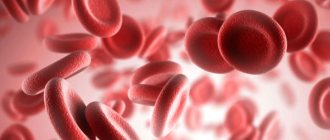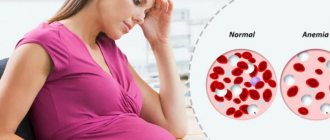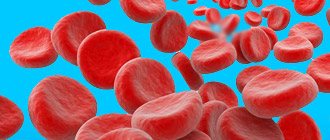| The problem of low hemoglobin is familiar to many pregnant women. But not everyone knows what consequences this problem can have, what it is fraught with, and do not take the doctor’s words seriously. This article will help you learn about the dangers of low hemoglobin levels in those who are pregnant. You will also learn about proper treatment. |
- What is low hemoglobin?
- Classification and causes of anemia
- Causes of low hemoglobin in pregnant women
- Symptoms
- Degrees
- Consequences of low hemoglobin levels
- Treatment
- Prevention
Classification and causes of anemia
- iron deficiency
It becomes a consequence of a drop in iron levels in the blood. The main reasons are constant bleeding (from the uterus, with hemorrhoids, with a duodenal ulcer, with an advanced stomach ulcer) and bearing a child.
- hemolytic
The reasons may be:
- exposure to cold
- genetic diseases
- poisoning of the body with heavy metals
- poisoning by poisons
- B12 deficiency anemia
Causes:
- parasitic infectious diseases
- impaired absorption of vitamin B12 in the small intestine
- unhealthy diet (a person eats foods that contain almost no vitamin B12)
- gestational (anemia of pregnant women)
Mostly, those who are carrying a child are diagnosed with anemia, which occurs when there is a lack of iron in the body.
- posthemorrhagic
It becomes a consequence of blood loss, and the reasons can be very different.
Why does anemia occur?
The main causes of anemia are:
- Iron deficiency if: there is not enough of it in food (unbalanced diet);
- it is not absorbed due to gastrointestinal problems;
- it is lost due to bleeding (hemorrhoids, exacerbation of peptic ulcer, taking drugs with salicylic acid or anticoagulants; myomatous nodes or hyperplasia, etc.).
The daily iron requirement of an adult is about 2 mg, and is usually met by dietary iron intake. A typical diet provides 5–15 mg of essential iron per day, of which about 10% is absorbed in the gastrointestinal tract.
Iron is distributed in the body as follows:
- Hemoglobin 1.5–3.0 g.
- Reserve iron (depot) - 0.5–1.5 g.
- Myoglobin, enzymes - 0.5 g.
- Transport iron - 0.003–0.004 g.
Normal iron reserves are about 1 g (1000 mg), they are stored in the liver and spleen in the form of compounds with proteins (ferritin, hemosiderin). If necessary, reserve iron in the form of ferritin is quickly released from the depot and enters the bone marrow to form hemoglobin.
Serum iron (or transport) continuously circulates in the blood, constantly entering the bone marrow for hemoglobin synthesis, into tissues for cellular respiration and into depot organs to replenish reserves. By its level you can judge the deficiency or saturation of the body with iron. When monitoring the level of serum iron in the blood, you should not take iron supplements for 3 days before the test.
The consequences of iron deficiency anemia during pregnancy are quite serious:
- In 30–50% of pregnant women, gestosis develops against the background of anemia (swelling, increased blood pressure, protein in the urine);
- In 10–40%, premature birth and weakness of labor are possible;
- One in 10 pregnant women suffers from postpartum hemorrhage;
- In 20%, fetal malnutrition (growth retardation) is detected;
- 10% have miscarriage.
During pregnancy, iron requirements increase to 6–8 mg/day by 32 weeks. These requirements can only be achieved by additional intake of iron into the body.
Causes of low hemoglobin in pregnant women
The following factors provoke a decrease in hemoglobin in pregnant women:
- increase in blood volume
The formation of the circulatory system of the embryo occurs, which during the gestational period is connected with the vessels of the expectant mother. The fetus has organs that produce blood. Therefore, as soon as the fetus develops, the blood volume gradually increases. Therefore, its amount becomes greater, but the amount of hemoglobin may not increase. This is typical for the twentieth and later weeks of gestation.
- needs of the future baby
As the embryo develops, it needs vitamins and other useful substances. He also needs iron. There is less iron in the blood, which is why a decrease in hemoglobin is recorded in a pregnant woman.
- multiple pregnancy
A multiple pregnancy is a pregnancy in which the mother is expecting two, three, four or more children. Since there are many children, they also need a lot of iron. If a pregnant woman’s body is low in zinc and copper, anemia may develop, and this is a dangerous condition.
- pregnancy soon after birth
It’s not for nothing that doctors say that you can’t give birth to children one after the other. Mom's body needs to recover. If very little time has passed since the previous birth (up to 3 years), then iron reserves are not restored. And the baby’s body takes this element from the mother, resulting in anemia.
- medication treatment
Some medications affect the absorption of iron and the amount of it in the mother's blood. Therefore, you need to be attentive to yourself, consult with a gynecologist about medications that you take a year or less before conception, as well as during pregnancy. Also remember that drug treatment in the first trimester almost always has a very negative effect on the condition of the embryo.
- bleeding associated with pregnancy pathologies
If a woman has lost a large amount of blood due to retrochorial hematoma, detachment of the ovum, placental abruption, or miscarriage, the result may be anemia. Experienced doctors prevent this condition in pregnant women.
- intestinal dysbiosis
Iron supplied with foods and dietary supplements is simply not fully absorbed into the gastrointestinal tract.
- changes in hormonal balance
The amount of estrogen hormones in the body increases after conception, which is necessary for normal childbearing. Therefore, iron is less absorbed in a woman’s intestines.
- nervous tension and constant stress
This factor can provoke not only low hemoglobin during pregnancy, but also other dangerous pathologies of the mother and unborn baby. Try to protect yourself as much as possible from worries, stressful work and communication with unpleasant individuals.
- exacerbation of chronic pathologies
Iron is consumed more if the pregnant woman begins to actively show symptoms of a chronic disease.
- toxicosis
In the first trimester, most women suffer from toxicosis. This condition includes nausea and vomiting. When vomiting, the absorption of iron and other useful substances becomes several times less, which ultimately leads to a decrease in hemoglobin.
In pregnant women, the lowest hemoglobin level is observed at the thirty-second or thirty-third week of gestation. And by the time of birth, hemoglobin increases, even if no measures are taken. In the first trimester, the mother's body needs as much iron as before pregnancy. Therefore, you do not need to take any medications, especially by your own decision. In the second trimester, the need increases by 2 times compared to the non-essential period. In the last trimester, iron requirements are five times higher.
The statistics of cases of anemia in pregnant women after the twentieth week of gestation is 10-20 times higher than the incidence statistics in the first trimester.
Why does hemoglobin level change during pregnancy and how to normalize it?
During pregnancy, it is advisable for women to undergo regular tests to determine the iron content in the blood and follow the doctor's instructions to maintain hemoglobin concentration. What complications can arise from iron deficiency?
During pregnancy and breastfeeding, the amount of iron in a woman’s body decreases. The role of iron in the body of a pregnant woman...
Iron deficiency in a child may be one of the consequences of iron deficiency anemia in a woman during pregnancy. Prevention of anemia during pregnancy...
A deficiency of hemoglobin in the blood can occur in women whose diet is unbalanced. How can you increase your hemoglobin level?
Women diagnosed with iron deficiency anemia most often need not only proper nutrition, but also taking iron-containing medications. Prevention of iron deficiency anemia...
Taking some dietary supplements can provide an additional source of iron. Why is low hemoglobin level in the blood dangerous?
"Ferrohematogen" is recommended as a dietary supplement to food as an additional source of iron, vitamins C, B6, B9 and copper. Find out the cost...
Dietary supplement Not a medicine.
Pregnancy is a period of joyful anticipation of meeting your baby. However, this time is often overshadowed by the not-so-good health of the expectant mother. Toxicosis, lack of calcium, vitamins, gestosis - this is an incomplete list of possible complications during pregnancy. One of the most common pathologies is a sharp decrease in hemoglobin levels. It can lead to serious health problems for the expectant mother and her child.
What is hemoglobin and why is it so important? Why can its content in a pregnant woman’s body decrease or increase? How to recognize anemia and how to get rid of it - we will consider all these questions in the article.
Hemoglobin and pregnancy
Hemoglobin is an iron-containing protein found in red blood cells. It is he who is responsible for the delivery of oxygen to every cell of the body and for the “utilization” of carbon dioxide.
By the way, one hemoglobin molecule contains four iron atoms. The share of such iron in the blood accounts for about 65% of the content of this element in the body. This is about 1.8–3.2 g.
During pregnancy, iron consumption increases significantly. The placenta grows, the fetus develops, a large number of new blood vessels are formed, and the baby begins to form its own blood cells. Starting from the 16th–18th week of pregnancy, the volume of blood plasma in the mother’s body increases by almost 40–50%[1]. But the number of red blood cells increases by only 25%. As a result, the blood becomes more “diluted” and hemoglobin levels drop. Throughout pregnancy, up to 1300 mg of iron is used to support the growing body, the placenta and the entire system that ensures its vital functions. And the need of the pregnant woman herself increases to 5.6–6 mg of iron per day.
Hemoglobin levels decrease during pregnancy in almost every woman. And about 1/3 of them develop anemia due to iron deficiency.
The hemoglobin level is determined during a general blood test. It is prescribed in the first trimester when a pregnant woman is registered, at 16–20 weeks, 24–28 weeks and 32–36 weeks. If deviations are detected in the analysis, it can be repeated. The doctor may also order serum iron, ferritin, and serum iron-binding capacity tests.
The analysis allows you to determine the amount of hemoglobin, color index, number of red blood cells and hematocrit - the number of blood cells in relation to its liquid part. A decrease in all these indicators indicates anemia.
Normal hemoglobin level during pregnancy
As we have already said, during pregnancy the boundaries of normal hemoglobin values shift slightly.
Hemoglobin content standards[2]:
- in a non-pregnant woman - 115-152 (average - 139) g/l;
- in the 1st trimester - 112–165 (average - 131) g/l;
- in the 2nd trimester - 108–144 (average - 120) g/l;
- in the 3rd trimester 110–140 (average - 112) g/l.
Due to the cessation of menstrual bleeding, hemoglobin in the blood of a pregnant woman may increase slightly in the 1st trimester. In the 2nd trimester, a large amount of iron is used to supply blood to the uterus and the developing fetus; blood volume increases faster than the number of red blood cells. In the 3rd trimester the situation continues: the increase in blood volume reaches a maximum at approximately 32 weeks.
If hemoglobin is high...
An increase in hemoglobin levels during pregnancy is rarely diagnosed and is usually a temporary phenomenon. For example, hemoglobin may be higher after poisoning, in hot weather, or when not drinking enough water. Hemoglobin may also increase due to stress or physical activity.
To correct a slightly elevated hemoglobin level during pregnancy, it is enough to follow a drinking regime and avoid stress, physical and emotional stress.
Hemoglobin more than 150–160 g/l may indicate serious illness. In order to understand the cause of this condition, you need to undergo a full examination.
Signs and causes of anemia
A decrease in hemoglobin levels during pregnancy occurs due to the fact that the need for this element significantly exceeds its supply. Monotonous or insufficient nutrition, diets, lack of certain vitamins and microelements, and a small amount of animal protein in the diet can have a negative impact. Additional risk factors are intestinal diseases, toxicosis, gestosis, kidney and liver diseases.
The degree of anemia is determined by the results of a blood test[3]:
- With moderate anemia, the hemoglobin level is 70–109 g/l, the hematocrit is 24–37%, the number of red blood cells is 2.5–3.9*1012;
- Severe anemia develops when hemoglobin drops to 40–69 g/l, hematocrit is 13–23%, and the number of red blood cells is 1.5–2.5*1012;
- With very severe anemia, hemoglobin drops below 40 g/l, hematocrit - less than 13%, and red blood cells - less than 1.5 * 1012.
Manifestations of clinically significant anemia may include:
- weakness, lethargy;
- brittle nails, hair problems;
- pallor;
- change in taste, addiction to unusual smells;
- palpitations, chest pain, shortness of breath.
Why is low hemoglobin dangerous during pregnancy?
With a lack of hemoglobin and the development of iron deficiency anemia, serious changes occur in the mother’s body:
- immunity decreases in proportion to the severity of anemia;
- signs of bleeding disorders appear;
- the risk of gestosis increases by 40%;
- the risk of toxicosis increases 1.5 times;
- placental insufficiency develops;
- fetal hypoxia develops;
- Preterm birth is 15–42% more likely;
- miscarriages are 8–9% more likely to occur;
- the likelihood of bleeding during or after childbirth increases;
- weakness of labor is more often observed;
- newborn children gain weight worse;
- purulent-septic diseases of newborns develop 2.2 times more often.
A child under 2 years of age is provided with 70% of iron from the mother. Low hemoglobin during pregnancy leads to serious consequences for the child and directly affects his health and proper development. Therefore, it is so important to fully provide the pregnant woman’s body with this microelement.
How to increase hemoglobin: recommendations during pregnancy
A nutritious diet can eliminate hidden iron deficiency and increase hemoglobin levels during pregnancy. To synthesize it, you need to eat protein foods of animal origin. It contains a complete set of amino acids that the human body needs.
Iron in meat has higher bioavailability compared to other foods. A person can absorb about 6% of this microelement from meat, while from plant products - only 0.2%[5].
Food should be varied. It should contain a large amount of vitamins and minerals that improve iron absorption, stimulate hemoglobin production and reduce the severity of anemia.
Products that increase hemoglobin during pregnancy are:
- beef;
- mushrooms;
- liver;
- eggs;
- seafood;
- buckwheat;
- legumes;
- greenery;
- nuts.
Many vitamins and microelements contained in foods help the absorption of iron and play a role in hematopoiesis. These same microelements began to be added to iron preparations in order to improve their bioavailability and enhance the effect:
- vitamin C improves iron absorption;
- vitamin B12 improves the condition of B12-deficiency anemia;
- folic acid has a good effect on the condition of the woman’s reproductive system;
- copper improves iron absorption and has an antioxidant effect;
- manganese improves hemoglobin synthesis and is an antioxidant.
Many preparations containing iron are produced in the form of tablets and capsules. They are convenient to use, have fairly high bioavailability, and the outer shell masks the unpleasant taste of iron salts. The disadvantages of this form of release are the inability to divide the dose of the drug and sometimes side effects. A large amount of iron is immediately released from the tablet, which negatively affects the intestinal mucosa. Slow-release iron tablets are better tolerated. They are convenient to use, but their bioavailability is lower and depends on food intake[6].
Iron supplements in the form of syrup or solution are better absorbed and well tolerated. The daily dose can be divided and, for example, diluted in your favorite juice. It is worth remembering that these drugs can stain the enamel of the teeth, so it is better to take them with a straw.
Iron supplements also have their disadvantages. Not all of them are well tolerated, especially during pregnancy. Common side effects of iron-containing medications include constipation, nausea, diarrhea, vomiting, and abdominal pain. Considering that a pregnant woman is already prone to constipation and nausea, therapy can turn into a not very pleasant process.
In any case, nutritional supplements allow you to more gently restore hemoglobin levels, minimizing the side effects of taking iron compounds. Of course, you should not count on dietary supplements as a panacea: with severe anemia, you cannot do without medications. But taking such supplements simultaneously with nutritional correction helps with hidden iron deficiency and serves to prevent the development of anemia.
The National Guidelines for Obstetrics recommend taking specialized nutritional supplements, including Hematogen, as a non-drug means of maintaining iron levels in the blood. This dietary supplement contains a large amount of black food albumin - a specially processed protein with a high iron content. In addition to hematogen, there are preparations in the form of tonics and soluble cocktails containing iron in a bioavailable form.
Iron is one of the most important elements for the body of a pregnant woman. Iron deficiency can negatively affect both the health of the mother and the health of the developing fetus. To prevent anemia, you need to monitor your diet, take nutritional supplements, and get all tests done in a timely manner. If it was not possible to avoid the development of anemia, you need to consult a doctor and select individual treatment with iron-containing drugs.
Hematogen as a means of preventing anemia during pregnancy
When talking about anemia, iron and hemoglobin, many will remember the hematogen familiar from childhood - tiles that taste like toffee.
We asked a representative to tell us how taking this dietary supplement can affect hemoglobin levels during pregnancy: “Initially, Hematogen was intended for therapeutic nutrition. It contains a large amount of iron and vitamins A, D, K, E, C and others. All substances are in a bioavailable form and “packed” in a tasty shell. For a pregnant woman, the best option would be hematogen without unnecessary flavorings and confectionery additives, for example, Ferrohematogen. It is made using patented technology from safe raw materials; in fact, it is an improved classic recipe. This dietary supplement helps to naturally restore hemoglobin levels and prevent anemia in pregnant women. The composition additionally includes vitamins C, B6 and folic acid, copper and iron salts. Thanks to these supplements, iron is well absorbed by the body. At the same time, hematogen does not cause side effects that are typical for drugs of this group, and is pleasant to the taste.”
PS You can find out more about Ferrohematogen on the website www.ferrogematogen.ru.
Sources:
- 1https://con-med.ru/magazines/gynecology/gynecology-02-2007/printsipy_profilaktiki_i_lecheniya_zhelezodefitsitnykh_anemiy_u_beremennykh/
- 2https://ok-dok.ru/knigi/nacionalnye/akusherstvo
- 3https://ok-dok.ru/knigi/nacionalnye/akusherstvo
- 4https://elibrary.ru/download/elibrary_23395893_48661935.pdf
- 5https://elibrary.ru/download/elibrary_23395893_48661935.pdf
- 6https://elibrary.ru/download/elibrary_22454414_85570504.pdf
Symptoms
An asymptomatic course is typical for low hemoglobin during pregnancy. Basically, symptoms make themselves felt immediately after the level of iron in the blood begins to fall. Common symptoms include:
- pale skin
- dizziness
- fatigue
- low performance
- weakness in the body
- shortness of breath even with minimal physical activity
- fainting
- brittle nails
- increase in heart rate
- severe hair loss on the scalp
- sores and cracks in the corners of the mouth
- desire to eat unusual or unintended foods
- desire to smell something that is unpleasant for ordinary people
A pregnant woman may have 1-2 symptoms listed in this list, but in such cases there is no need to immediately diagnose yourself with anemia. A couple of symptoms may also indicate completely different conditions, including toxicosis of the first trimester and its consequences. Therefore, it is important to consult a doctor so that he can prescribe tests and conduct the necessary studies to make a clear diagnosis.
Symptoms of anemia during pregnancy
With iron deficiency during pregnancy, the following symptoms are observed:
- Constant weakness, possible fainting.
- Dizziness.
- Pale, dry, flaky skin.
- Pale mucous membranes (lips, eyelids, etc.).
- Depressed mood, irritability, drowsiness.
- Tachycardia (heart beats quickly - more than 90 beats per minute).
- Brittle nails with white spots.
- Brittle, dull hair with split ends.
- Non-standard taste preferences (for example, when you want to eat chalk or sand).
If the hemoglobin level decreases gradually, then the expectant mother may feel well for a long time, although the problem still exists. Therefore, it is important to regularly take all the tests prescribed during pregnancy. Anemia will be detected by a complete blood test.
Degrees
There are three degrees of drop in hemoglobin levels in women expecting a child:
- first (per 1 liter of blood 90-110 g of hemoglobin; mostly occurs hidden)
- second (the degree is considered average, 70-90 grams of hemoglobin are detected per 1 liter of blood; here the symptoms are more likely, but they are not alarming, so the woman may not contact a gynecologist in time)
- third (in the blood there is less than 70 grams of hemoglobin per liter, a lot of symptoms appear)
The third degree is considered severe, and there may be irreversible consequences for the unborn baby and his mother.
Necessary tests
All pregnant women must have their fasting venous blood plasma glucose tested in a laboratory (cannot be tested using portable glucose self-monitoring devices - glucometers!) - against the background of a normal diet and physical activity - upon first contact with the antenatal clinic or perinatal center (as possible earlier!), but no later than 24 weeks of pregnancy. It should be remembered that during pregnancy the blood glucose level on an empty stomach is lower, and after eating it is higher than outside pregnancy!
Pregnant women whose blood glucose levels, according to WHO recommendations, meet the diagnostic criteria for diabetes mellitus or impaired glucose tolerance are diagnosed with gestational diabetes mellitus. If the results of the study correspond to normal indicators during pregnancy, then an oral glucose tolerance test - OGTT ("stress test" with 75 g of glucose) is mandatory at 24-28 weeks of pregnancy in order to actively identify possible disorders of carbohydrate metabolism. All over the world, OGTT with 75 g of glucose is a safe and the only diagnostic test for detecting disorders of carbohydrate metabolism during pregnancy!
| Research time | Venous plasma glucose | ||
| On an empty stomach | > 7.0 mmol/l (> 126 mg/dl) | > 5.1 < 7.0 mmol/l (>92<126 mg/dl) | <5.1 mmol/L (<92 mg/dL) |
| At any time of the day if there are symptoms of hyperglycemia (dry mouth, thirst, increased volume of urine excreted per day, itching, etc.) | > 11.1 mmol/l | — | — |
| Glycated hemoglobin (HbA1C) | > 6,5% | — | — |
| OGTT with 75 g anhydrous glucose h/w 1 hour after meals | — | >10 mmol/l (>180 mg/dl) | < 10 mmol/l (<180 mg/dl) |
| OGTT with 75 g anhydrous glucose h/w 2 hours after meals | — | > 8.5 mmol/l (> 153 mg/dl) | <8.5 mmol/l (<153 mg/dl) |
| Diagnosis | diabetes mellitus type 1 or 2 during pregnancy | Gestational diabetes mellitus | Physiological blood glucose levels during pregnancy |
Remember that normalizing carbohydrate metabolism in a pregnant woman allows you to avoid complications from both the course of pregnancy itself and the condition of the fetus!
After a diagnosis of gestational diabetes mellitus is made, all women require constant monitoring by an endocrinologist together with an obstetrician-gynecologist. Pregnant women should be trained in the principles of rational nutrition, self-control and behavior in conditions of a new pathological condition (i.e., timely testing and visits to specialists - at least once every 2 weeks).
A pregnant woman's diet should be sufficiently high in calories and balanced in basic food ingredients to provide the developing fetus with all the necessary nutrients. At the same time, in women with gestational diabetes mellitus, taking into account the characteristics of the pathological condition, nutrition should be adjusted. The basic principles of diet therapy include ensuring stable normoglycemia (maintaining blood glucose levels corresponding to those for physiological pregnancy), and preventing ketonemia (the appearance of fat breakdown products - “hungry” ketones - in the urine), as mentioned above in the text.
Increased postprandial blood glucose levels (above 6.7 mmol/L) are associated with an increased incidence of fetal macrosomia. Therefore, a pregnant woman should exclude easily digestible carbohydrates from food (which lead to a rapid uncontrollable rise in blood glucose) and give preference in the diet to difficult-to-digest carbohydrates high in dietary fiber - carbohydrates protected by dietary fiber (for example, many vegetables, legumes) have a low glycemic index. The glycemic index (GI) is a factor in the rate of absorption of carbohydrates.
Consequences of low hemoglobin levels
- gestosis
The pregnant woman develops edema, her blood pressure rises, and protein is found in the urine when the appropriate analysis is performed. The liver cannot function normally, less protein is produced than the body needs, and water metabolism is significantly disrupted. If the course of gestosis is severe, the pregnant woman’s brain will lack oxygen, followed by headaches. Sometimes preeclampsia is diagnosed, and in the absence of therapeutic measures taken, eclampsia. In the latter case, the pregnancy is terminated for medical reasons.
- embryonic development delay
If there is not enough oxygen in the mother’s body, then the child also lacks it. Its development becomes slow, and first of all, a very important organ, the brain, suffers.
- risk of premature birth
Low hemoglobin during pregnancy can lead to early placental abruption. If medical assistance is not quickly provided, the fetus may die, and there is also a risk of death of the mother. If the third degree of anemia is observed, then in 12 cases out of 100 the child is born dead.
- risk of infectious diseases after childbirth
- bleeding during childbirth or weakness of labor
- lactation disorders
Among the long-term consequences, as scientists from the United States write, is senile dementia. The study, which was conducted over eleven years, showed that with low hemoglobin levels, the risk of dementia in the elderly increases by 41%. The reason is that oxygen starvation leads to the death of neurons.
How to prevent anemia?
Treatment of anemia is based on the use of iron supplements and a balanced diet. Here are data on the iron content of some foods (mg iron per 100 g of food):
- Liver, oatmeal, beans, beans, soybeans - 5–15 mg.
- Eggs, meat, fish, spinach, prunes, apricots, bread - 1–5 mg.
- Milk, potatoes, carrots, beets, apples - less than 1 mg.
But I repeat, the maximum amount of iron that we can get from food is 2.5 mg/day! Therefore, during pregnancy you need to additionally take vitamin complexes with iron or iron supplements according to indications. The course of treatment is usually 1–1.5 months.
Do not be ill!
Treatment
It is important to pay attention to nutrition, but this does not replace taking medications prescribed by your doctor. A pregnant woman in the second trimester needs 3 or 4 mg of iron per day. In the last 3 months of gestation, the need is greater; as already noted, it is approximately 10 mg. Diet to treat low hemoglobin in a pregnant woman is not enough. A day, eating right, you can get only 1 mg of iron with food, and this is too little.
If little iron is supplied with food, then the body will initially use what is stored in the depot “in reserve.” But by the twentieth week, in such a situation, it is already possible to receive a diagnosis of anemia.
There are 2 types of iron : heme and non-heme. The latter type is found in our food, but it is not reflected in the level of hemoglobin in the blood. This is another fact in favor of refuting the myth about adjusting hemoglobin levels during pregnancy with a balanced diet. Yes, eating right is important, but in the case of anemia, it is only one step towards recovery.
Leading products in iron content:
- liver
- meat
- eggs
- fish
- spinach
- apricot
- pomegranate
- oatmeal
- beet
- peaches
The human body absorbs about 6% of iron from animal products, and 0.2% of the total iron it contains from plant products.
Treatment with drugs
To adjust hemoglobin levels, it is important to take medications with heme iron. Its absorption occurs at a higher level, so there is more hemoglobin in the blood in a short time. The drugs must be prescribed on a case-by-case basis by the attending physician. The dosage may vary for all pregnant women.
Drugs for the treatment of anemia:
- Maltofer
- Tardiferon
- Sorbifer
- Totema
- Ferrum Lek
When prescribing, the doctor takes into account the degree of anemia the patient has and whether she has intolerance to the drug.
When is anemia diagnosed?
The normal level of hemoglobin in the blood according to different values is from 110 to 144 g/l. The lower the indicator, the more severe the form of the disease:
- a decrease in hemoglobin below a minimum value of 110 to 90 g/l is considered mild anemia;
- 89–70/l - average level;
- below 70 g/l - severe anemia.
Anemia is one of the most common problems that occurs during pregnancy, its frequency reaches 58%. A slight decrease in hemoglobin levels during pregnancy is possible (normally by the 32nd week of pregnancy), due to the fact that the volume of circulating plasma in a woman’s body increases by 50%, and the number of red blood cells increases by only 18–20%.









